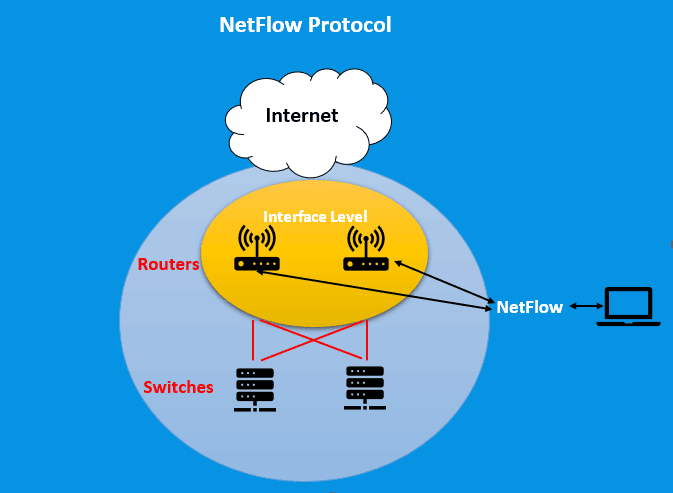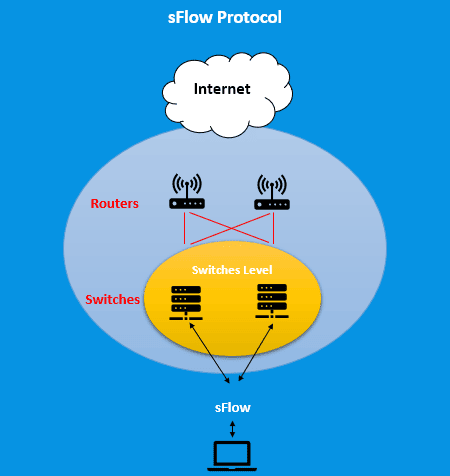1. Introduction
Network traffic monitoring is a critical step in managing and maintaining the performance and security of any network.
Nowadays, NetFlow and sFlow are two of the most popular traffic monitoring protocols. However, we can use both protocols to keep an eye on network traffic.
In this tutorial, we’ll explore the differences between NetFlow and sFlow.
2. What Is NetFlow?
NetFlow is a protocol powered by Cisco Systems to gather information about the data being sent over a network. In particular, NetFlow monitors network traffic at the interface level by collecting data on every packet that enters or exits the interface.
Moreover, the data collected by NetFlow includes the source and destination IP addresses, the protocol used, the number of packets and bytes sent, and the timestamp of each packet:

3. What Is sFlow?
sFlow is a protocol created by InMon Corporation to monitor network traffic. It collects data on a portion of the network packets rather than on every packet like NetFlow.
Instead of tracking the packets at the interface level, sFlow monitors them at the switch level. It records information such as where the data is coming from and going to, the protocol being used, and when each packet was sent:

4. Differences Between NetFlow and sFlow
There are several differences between NetFlow and sFlow, such as sampling method, amount of data collected, impact on network performance, protocol support, configuration, and compatibility with flow analysis tools.
4.1. Sampling Method
The most significant difference between NetFlow and sFlow is their sampling method. NetFlow monitors network traffic at the interface level and collects data on every packet that enters or exits the interface. In contrast, sFlow samples network traffic at the switch level and collects data on a subset of the packets.
4.2. Amount of Data Collected
Since NetFlow collects data on every packet that enters or exits the interface, it generates a large amount of data. In contrast, sFlow collects data on a subset of the packets, generating less data.
Moreover, network administrators may find it challenging to manage the significant amount of data collected by NetFlow, whereas sFlow’s reduced data collection can make it easier to manage.
4.3. Impact on Network Performance
Because NetFlow collects data on every packet, it can significantly impact network performance. In particular, NetFlow can cause a bottleneck in network traffic and can result in packet loss. In contrast, sFlow minimizes network performance, as it samples a subset of the packets.
4.4. Protocol Support
NetFlow is a protocol Cisco Systems developed and supported by most Cisco devices. On the other hand, a broader range of network devices, including Cisco, Juniper Networks, and Hewlett-Packard, support sFlow.
4.5. Configuration
To use NetFlow, we need to configure each interface we want to monitor, which can be time-consuming. In contrast, sFlow only requires configuration on the switch, making it easier and faster to configure.
4.6. Compatibility with Flow Analysis Tools
Because NetFlow is a protocol developed by Cisco Systems, it is most commonly used with Cisco’s flow analysis tools. In contrast, sFlow is a more open protocol that is compatible with a broader range of flow analysis tools.
4.7. Summary of Differences
The following table summarizes these main differences:
Aspect
NetFlow
sFlow
Sampling method
Monitors at the interface level and collects data on every packet
Samples network traffic at the switch level and collects data on a subset of the packets
The amount of data collected
Generates a large number of data
Generates fewer data
Impact on network performance
Can cause a bottleneck and packet loss
Has a minimal impact on network performance
Protocol support
Developed by Cisco and supported by most Cisco devices
Supported by a broader range of network devices from Cisco, Juniper Networks, and Hewlett-Packard
Configuration
Each interface to be monitored requires configuration, time-consuming
Requires configuration only on the switch, easier and faster to configure
Compatibility with flow analysis tools
Most used with Cisco’s flow analysis tools
Compatible with a broader range of flow analysis tools
5. Use Cases for NetFlow and sFlow
We can utilize both protocols for network traffic monitoring, but they may be better suited for different scenarios.
5.1. Use Cases for NetFlow
NetFlow is a good choice for monitoring traffic in high-speed networks with large traffic volumes. It is also useful for detecting security threats and attacks, identifying congestion points, and optimizing network performance.
Furthermore, NetFlow can provide detailed information on traffic flows to help network administrators troubleshoot network problems, plan network upgrades, and optimize bandwidth utilization.
5.2. Use Cases for sFlow
sFlow is a good choice for monitoring traffic on networks with limited bandwidth, such as branch offices, small data centers, and remote locations. sFlow’s sampling method allows it to collect data on a subset of the packets, making it less resource-intensive than NetFlow.
Moreover, sFlow can provide an overview of network traffic patterns that can help network administrators detect anomalies and optimize network performance. It is also useful for monitoring network security and identifying potential security threats.
Overall, understanding the typical use cases for NetFlow and sFlow can help network administrators choose the appropriate protocol for their network traffic monitoring needs.
6. Conclusion
In this article, we explored NetFlow and sFlow, popular protocols for monitoring network traffic.
Network administrators must grasp the differences between these two protocols, as it’ll enable them to select the perfect one that fits their specific network traffic monitoring needs.